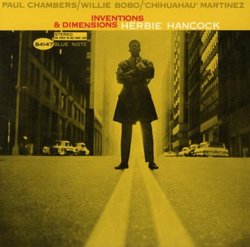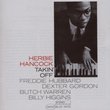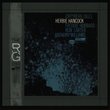| All Artists: Herbie Hancock Title: Inventions & Dimensions Members Wishing: 2 Total Copies: 0 Label: Toshiba EMI Japan Release Date: 4/27/2004 Album Type: Import, Limited Edition, Original recording remastered Genres: Jazz, Pop, R&B Styles: Jazz Fusion, Modern Postbebop, Bebop Number of Discs: 1 SwapaCD Credits: 1 |
Search - Herbie Hancock :: Inventions & Dimensions
 | Herbie Hancock Inventions & Dimensions Genres: Jazz, Pop, R&B
For his third album, Herbie Hancock chose a very rhythmic setting for his improvised compositions. Supported only by bassist Paul Chambers and percussionists Willie Bobo and Osvaldo Martinez, the pianist creates each tune ... more » |
Larger Image |
CD DetailsSynopsis
Album Description For his third album, Herbie Hancock chose a very rhythmic setting for his improvised compositions. Supported only by bassist Paul Chambers and percussionists Willie Bobo and Osvaldo Martinez, the pianist creates each tune from scratch and the results are astonishing. The alternate take of "Mimosa" has previously only been available as part of box set. *bonus tracks, not part of the original LP HERBIE HANCOCK, piano PAUL CHAMBERS, bass WILLIE BOBO, drums, timbales OSVALDO "CHIHUAHUA" MARTINEZ, congas, bongos, guiro, finger cymbals Similar CDs
|
CD ReviewsUnlike any Herbie Hancock you've heard before Michael Hardin | South Duxbury, Vermont United States | 05/24/2006 (4 out of 5 stars) "I am a jazz pianist and Herbie Hancock is a personal favorite of mine, and he is certainly one of the most versatile musicians to ever come out of jazz. His music and his playing is anywhere from ridiculously funky to absolutely beautiful to out there and crazy. This album, from 1963, most closely follows the third option. One has to wonder where this session came from; Hancock had found his first hit with "Watermelon Man" and spent his second session trying to duplicate that success, albeit with mixed results. This third session for Blue Note sounds nothing like the first two or almost anything in the Blue Note catalogue at that time. Stripped down to trio plus auxiliary percussion with Paul Chambers on bass, Willie Bobo on drums, and Osvaldo Martinez on auxiliary percussion, the group explores Latin grooves in a very subtle way that I can only label "concept-based post-bop." There aren't really any written tunes ("Mimosa" was a set of chord changes and the other tunes are completely improvised) so sketches are built more off of fragments and ideas born in the studio. For example, one tune features the bass playing a pedal tone for four bars followed by Hancock's improvisation in that key for sixteen bars. The music, while abstract, is oddly infectious through the rhythmic approach. In addition, Hancock was working with fairly "inside" musicians, especially Chambers, a first call bop musician. As a result, though free, this music is fairly conservative. Whether or not this is a good thing is a matter of taste; it is controlled and in what many would call "good taste" but at the same time, sometimes that control inhibits the musicians from reaching the full potential of the wild and crazy things that *might* have been born. Thus, this was never able to reach the classic status of the great "out" sessions but it was also kept from descending into meaningless noise that happens when free jazz finds itself uninspired. Instead, it walks a middle path, a relatively safe (though still more adventurous than either of his prior two releases) "free" session which is very interesting, sometimes catchy, but not really a classic. I find it difficult to call any of this session to mind because there aren't memorable melodic moments; it's more about texture. I still enjoy this quite a bit, though, and anyone interested in Herbie Hancock would do well to check out this album to see the germ of his playing with Miles, or perhaps a road he chose not to take." Why Herbie Hancock Is A Musical Giant SFHoliday | 01/09/2008 (5 out of 5 stars) "As another reviewer said, you wouldn't realize these compositions are improvised unless you read the liner notes. I first heard this album, original issue, in Santa Barbara in 1982, and its compositions have remained with me since. This music nourishes the mind, as well as the emotions. Listen closely to Succotash: each musical phrase is worthy of expansion into its own composition. Every improvising musician should own and listen to this album. If you appreciate improvisation at a high level, density, non-derivative, yet still accessible music, add Inventions & Dimensions to your collection."
|

 Track Listings (5) - Disc #1
Track Listings (5) - Disc #1

